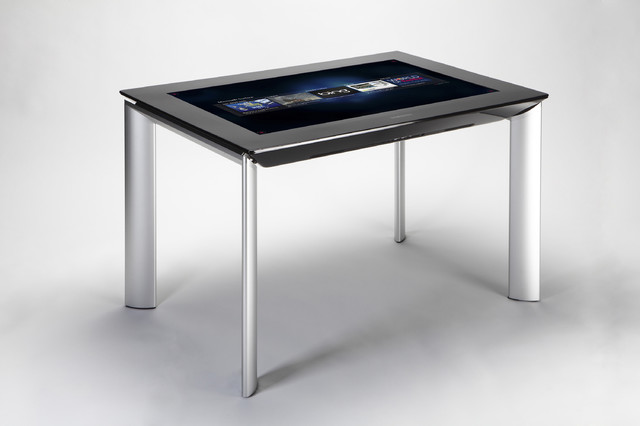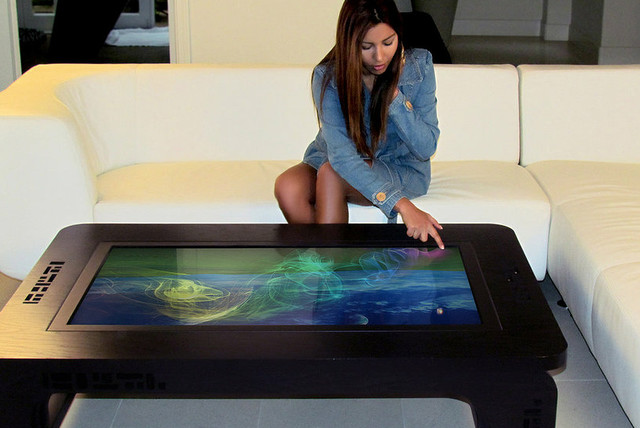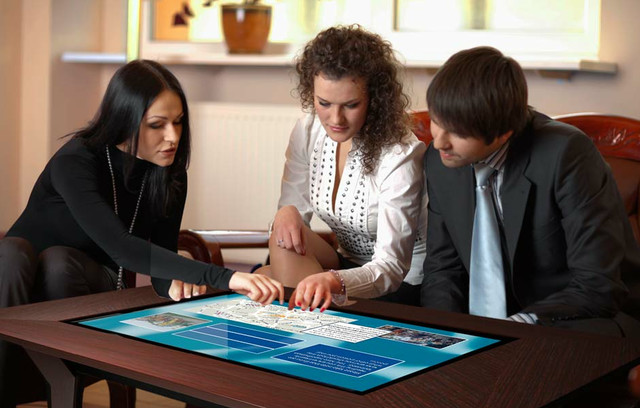Computers started out as discrete objects to be placed on top of furniture â a PC on the desk, a laptop on the dining room table. An iPad on the kitchen counter. But the destiny of computing devices is to be built into our furniture. The desk itself will become a PC. The dining room table will be usable like a laptop. And the kitchen counter will work a lot like an iPad.
In computer science, the concept of computers built into everything is called ubiquitous computing, pervasive computing, ambient intelligence or, my favorite label: everyware.
The transition to intelligent furniture will also involve a reconsideration of the hierarchy of furniture. For example, the tables throughout your house exist in a functional ranking system. Today the king of tables, of course, is the dining room table. You spend more money on it than other tables, such as bedroom nightstands, the coffee table, the patio table, the workbench in the garage, the desk in your home office and so on. Its quality, appearance and placement are far more important than that of lesser tables.
When the dust settles on the transition to intelligent furniture, however, it's likely that the lowly coffee table will usurp the crown and become the most important (and expensive) table in your house. The reason is that the current location and purpose of a coffee table as a table are peripheral to what's important about your family's life. But the intelligent coffee table of the future may be the central computing device in your home.
|
|
The ultimate coffee table book is itself a coffee table. Have you ever wondered why coffee table books exist? It's a pretty strange literary genre, if you think about it. It's the only category of printed content that's expressly designed to sit on a specific piece of furniture.
Wikipedia has a nice entry on the coffee table: "A coffee table book is a hardcover book that is intended to sit on a coffee table or similar surface in an area where guests sit and are entertained, thus inspiring conversation or alleviating boredom. They tend to be oversized and of heavy construction, since there is no pressing need for portability."
In the relentless drive to turn physical things into virtual ones, the purpose served by the coffee table book will soon be served by the coffee table itself, and for the same reasons. The coffee table as a computer will help you entertain guests and stimulate conversation. It will also control other smart appliances in the house, such as the TV.
The best example of this technology is a product from Samsung called the SUR40 with Microsoft PixelSense. Here's a nice video that shows off some of the amazing capabilities of PixelSense. Currently, the SUR40 isn't sold to consumers; it's sold mostly to bars, casinos and retail stores.
Microsoft has made no secret of its intention to make PixelSense tables available for consumers. It's probably just waiting for the prices of electronic components to come down far enough so the tables can sell for less than £3,000 or so.
|
|
|
The smart coffee table of the future will be central. The Samsung SUR40 with Microsoft PixelSense does many of the things that tomorrowâs interactive coffee tables will do, but itâs not ready for the consumer market. The Mozayo M42-Pro is ready for the consumer market, but it canât really do the things that will make future interactive coffee tables compelling.
The next generation of smart coffee tables will look like a combination of the two. (This photo shows one custom variation of the Samsung SUR40, illustrating how people will be drawn to smart coffee tables as a central sources of entertainment and information.)
Imagine a coffee table with a smooth, all-glass surface. When you touch it with your hand, it will come alive. Gestures such as swiping up will bring up various options. While the surface of the table is lit, various objects, such as phones, will be recognized by the table, enabling neat tricks. For example, by placing a smart phone on the table, it not only will know who you are but will enable you to selectively spill out digital pictures and videos onto the table.
Board games will be replaced by smart board pieces. Presenting future Monopoly items (the little dog, the top hat etc.), the table will turn into an interactive Monopoly board. All the Community Chest cards, money and the rest will be served up on the surface of the coffee table.
Draw the letter "K" (for keyboard) with your finger, and a keyboard with document will appear on the screen. After writing something, you'll be able to send it via email, post it on Facebook or do any number of other things with it. Another gesture will bring up a TV remote control function or controls for various lights and other items in the house.
In short, the interactive coffee table of the future will do just about anything you want it to. And it will cost a lot less than todayâs £10,000-plus tables.
Ultimately, the reason coffee tables will reign supreme is that youâre going to have a large, flat surface in the middle of your living room surrounded by chairs where people will spend a lot of time anyway. Itâs the ideal scenario for a massively powerful computer with a big, beautiful touch screen that can conjure up anything you and your family desire.
Ubiquitous computing is coming. You'll have little computers in many of your appliances and furniture pieces, and a big computer with a big screen right there in your living room. Tomorrow's smart coffee table will do absolutely anything. You'll even be able to set your coffee cup on it. (Please use a coaster!)
|


